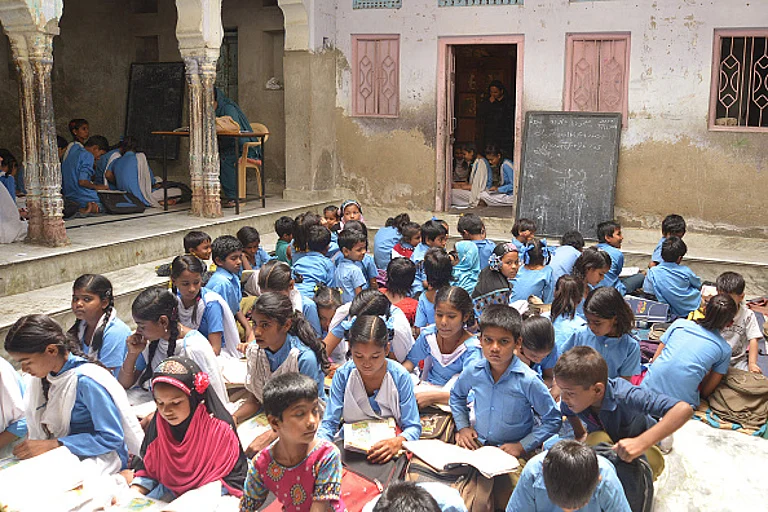Hina Rabbani Khar, the elegantly coiffed, scarved and attired foreign minister of Pakistan and a leading fashionista of the country, has a present waiting for her from New Delhi that is bound to delight her. She has already admired a specimen on a Pakistani journalist, and as news reached India of her interest, a Bengali admirer quickly bought her the article to take back to Islamabad.
The gift is an Indian silk sari scarf from the House of Wandering Silk (HOWS). Khar could drape it around her shoulders, matching it with her silk shalwar kamizes, fashionably wear it around her neck while wearing jeans, or even pair it with breeches, when she is riding her favourite horse. One should think a larger one, tied across her head, could even keep her warm on one of her treks to K2 or Nanga Parbat.
Little known to Khar, even as her understated Japanese pearls might nestle in the folds of the scarf, these products change lives for the better.
Fabrics from the New Delhi-based HOWS, a fair trade organisation, is aimed at “adjusting...some of the inequalities around us...while respecting the natural environment in which we work”. It seeks to provide dignified employment to disadvantaged women, and proceeds from sales benefit marginalised women from cooperatives and NGOs which train and support them. A portion of the proceeds funds a school in West Bengal; another portion supports a school for tribal children in Madhya Pradesh.
In Islamabad’s drawing rooms, HOWS’s silk scarves turn heads; it’s the latest must-have ethnic chic. Invisible borders are crossed as Pakistani women try to find out if they can order online for the products from New Delhi.
Posh Pakistani begums in Islamabad, Karachi, Lahore and Peshawar may drool over the exquisite fabrics, but, unbeknownst to them, the production trail ends in Murshidabad district, West Bengal, with a woman artisan who spends hours filling in the exquisite embroidery that adorns these sari scarves. As buyers, they indirectly help her and others, but the Pakistani aficionados would know her name, embroidered in Bengali on each scarf, only when it is translated into English in an accompanying tag. Many, if not all, the ‘ikat’ saris come from Orissa and Gujarat. Orissa, in particular, weaves a lot of ‘ikat’, and many of the most beautiful scarves also come from there.

The brainchild behind HOWS, this silken bridge between the two countries, is a Czech-Australian woman, Katherine Neumann, a humanitarian aid worker with experiences in Africa, Asia and the Middle East. The idea behind HOWS, she says, is simple: to promote high quality, unique and sustainable products, to prove that “fair trade” doesn’t have to be limited to lower-quality “gift items”.
“I was in Pakistan from 2005-2007, following the earthquake in Kashmir. I was based mostly in Mansehra, in the former NWFP. I just loved it; though it wasn’t so easy living there, Pakistan has a very special place in my heart,” Katherine tells Outlook.
Katherine has worked extensively with impoverished and vulnerable communities in disaster-hit areas in the past, helping in their rehabilitation as well as the long-term development of their villages.
“I’ve been witness to the huge resources committed to development, and while often there are successes, especially in disaster relief work, I also see the lack of sustainability in much of it, with gains lost once the NGOs leave, which inevitably many do and indeed should. I started becoming interested in the more long-term tools of development, such as microcredit and social enterprise, which in my experience and opinion offer a much more sustainable way out of poverty,” she explains.
On a blazing June day, the influential and beautiful thronged to Nomad’s Art Gallery, on a leafy Islamabad avenue, to get a glimpse of the Indian scarves from HOWS. Nomad’s director, Nageen Hyat, told Outlook: “This is the first time we are stocking Indian merchandise.” Sari, Silk, Scarves, India—these are the four magical words that prompted one lady at the exhibition to snap up five scarves even before they could be displayed. Some of the scarves display the traditional ‘kantha stitch’ from Bengal, and brighten up shelves stocked with work of leading Pakistani artists.
“My first reaction to the great response accorded to our fare so far in Pakistan was one of joy: the country is special to me and it’s very satisfying to think of these products being worn by women on the other side of the border. I remember the interest among many of my Pakistani friends in the saris, however, and so I wasn’t so surprised at the interest shown in up-cycled sari products,” says Katherine.
Katherine sees a bigger market for her products emerging in Pakistan, as word has spread and there is interest in Peshawar, Karachi and Lahore.
“We are presently only stocking in Islamabad but would like to look for retail partners in the other key cities in Pakistan to meet demand. Pakistanis aren’t yet purchasing online; I think it takes time for people to know the product and trust the brand before they are willing to purchase online. I believe there is a genuine and deep interest among many Pakistanis in Indian textiles and embroidery. After all, it is to some degree a shared heritage,” she adds.
Of all her sources, a collective of hundreds of women from the rural depths of Murshidabad in West Bengal has impressed Katherine the most for the high quality of artistry invested in the work. The collective was started by the inspirational Shabnam Ramaswamy from Murshidabad. Most of the artisans under her would not be allowed by their families to do any other work.
“They take the material home to work on the scarves, and do the work along with all their household chores. Traditionally, women in Bengal do ‘kantha stitch’ on old, damaged cotton saris and recycle them into light blankets for domestic use. These women have been creating new kantha products for several years now, and you can already see signs of prosperity, such as mud houses being turned into pucca houses. Part of the proceeds earned from their work go towards supporting the local school, also set up and managed by Ms Ramaswamy’s organisation, India Street Survivors,” says Katherine.
HOWS intends at some point in the near future to start working with Pakistani cooperatives and NGOs to create products that could, conversely, be exported to India and other countries.
“I see the exquisite textile-related skills existing in Pakistan as a largely undervalued—at least internationally so—cultural resource. ‘Justi’, from the Hazara region, ‘Swati’ embroidered cushions, ‘Balochi’ kameezes and handwoven lungis from Sindh will sell very well internationally,” says Katherine.





















